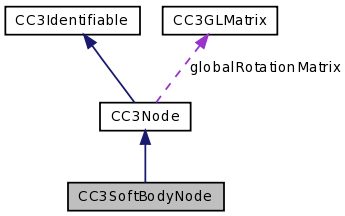CC3SoftBodyNode is the primary structural component for a soft-body object that uses vertex skinning to manipulate and draw mesh vertices. More...
#import <CC3VertexSkinning.h>


Detailed Description
CC3SoftBodyNode is the primary structural component for a soft-body object that uses vertex skinning to manipulate and draw mesh vertices.
Vertex skinning is a feature of OpenGL that allows the vertices of a mesh to be manipulated or deformed using an underlying skeleton of bones. This feature is also sometimes referred to as bone-rigging. This feature is used to create realistic movement in soft-body, flexible meshes, such as characters or textiles.
A soft-body object consists of two primary components: a skeletal structure, and the skin that covers it. The skeletal structure is constructed from an assembly of CC3Bone instances, and the skin is constructed from one or more CC3SkinMeshNode instances. The CC3SoftBodyNode instance then serves to collect together the bones and skin components, and forms the root of the soft-body object.
The vertices of the skin mesh forms the skin that surrounds the bones of the skeleton. During movement and drawing, the location and rotation of each bone in the skeleton influences the locations of the skin vertices that are attached to that bone. Some skin vertices, particularly those around joints where two bones meet, can be associated with more than one bone, and in that case, the influence that each bone has on the location of a vertex is determined by a weighting associated with each bone for that vertex.
The CC3Bone instances are typically assembled into a structural assembly of bones known as a skeleton. The purpose of this skeletal structure is to allow the bones to move and interact with each other in a hierarchical manner.
A CC3SkinMeshNode instance represents the skin that covers the skeleton, and contains the mesh that makes up the skin, in the form of a CC3SkinMesh. This mesh includes the bone assignments and weights for each vertex, which specifies how the location of each vertex is influenced by the location and orientation of each nearby bone.
A single soft-body object may be covered by a single skin mesh, but more complicated objects may be covered by several skin meshes. As such, a single CC3SoftBodyNode instance may contain one or more CC3SkinMeshNode instances.
For efficiency and control, each skin mesh is usually broken into sections. These skin sections are represented by instances of the CC3SkinSection class. A CC3SkinMeshNode typically holds a single CC3SkinMesh, and several CC3SkinSection instances to define how that skin mesh should be divided into sections. Each CC3SkinSection instance contains a range of vertices, and references to the bones in the skeleton that influence the vertices in that range. All of the vertices of a single CC3SkinSection are drawn in a single GL drawing call.
Manipulation of the bones in the skeleton will cause the soft-body to move and flex internally. In addition, like any node, a CC3SoftBodyNode can be moved, rotated and scaled to move, rotate and scale the entire soft-body assembly of skin and bones as a unit. By combining both internal bone animation with movement of the entire CC3SoftBodyNode, you can create realistic movement of your soft-body objects.
For example, if your CC3SoftBodyNode represents a character, you could animate the bones in the skeleton within the node to crouch down and then stand up again. During the standing up animation, you could move the entire CC3SoftBodyNode upwards to create a realistic jumping action. Or, you could simply animate the bones in the skeleton through a loop of a step of a walking motion, while at the same time moving the CC3SoftBodyNode forward, making it appear that the character was walking forward.
The initial assembly of CC3Bone nodes should be arranged into what is termed the "rest pose". This is the alignment of the bones that will fit the undeformed positions of the vertices that make up the skin. In the rest pose, the bones have no deforming effect on the skin vertices.
Once the initial skeleton has been assembled into the rest pose, you should invoke the bindRestPose method on the CC3SoftBodyNode instance (or any ancestor node of the CC3SoftBodyNode instance) to cause the bones and skin (CC3Bones & CC3SkinMeshNodes) to cache this pose.
Subsequent movement of the bones in the skeleton deform the skin vertices relative to this rest pose, affecting the location of the vertices in the mesh.
In almost all soft-body objects, all internal movement of the object is handled via manipulation of the bones. The CC3SkinMeshNodes should not be moved or rotated directly, otherwise the skin will become detached from the bones. However, if you have reason to move the skin mesh nodes, you should re-establish the rest pose and invoke the bindRestPose method again to re-align the bones with the skin.
If the CC3SoftBodyNode has been assembled from a file loader, the bindRestPose method will be invoked automatically, and you do not need to invoke it explicitly.
The documentation for this class was generated from the following file:
 1.7.2
1.7.2